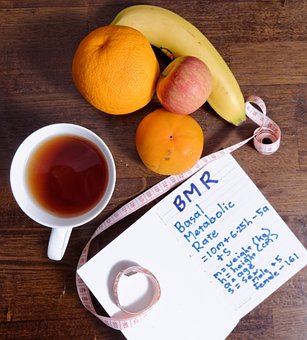
Remember that the macronutrients you consume can either be converted for energy, saved, or used to produce bigger molecules. A nutrient’s metabolic path is dependent upon energy balance. When you consume more nutrients than you use, the extra energy will be either stored up or used for things like development (e.g., while in childhood, while pregnant, or when healing from an injury). When you don’t intake adequate energy to satisfy your requirements, your body will be forced to draw energy from its reserves. An equal amount of energy is consumed as is used. Body weight can be regarded as a representation of a person’s overall energy balance. When energy levels are in equilibrium, the body weight is sustained; if the energy intake or input is smaller than the energy output or expenditure, the body weight decreases; and when the energy intake or input is greater than the output or expenditure, the body weight increases. When you consume the same amount of energy as your body requires, your weight will remain steady whatever that may be. Individuals who are carrying excess weight or are obese can maintain an equilibrium between consumed and expended energy. Essentially, their calorie intake is balanced with the amount of energy they use, but at certain times in their life, they have taken in more energy than they have expended. Generally speaking, body mass is a reliable indicator of energy balance, however, other elements influence how much energy is consumed and how much is utilized. Certain aspects of this can be managed by you and other elements cannot be changed.
One pound of body fat is roughly equivalent to 3,500 kilocalories, and one kilogram is equal to 7,700 kilocalories. If you eat an additional 10 calories each day than what is necessary, you will gain 1 pound per year. If you consume 100 excess kilocalories each day, the equivalent of one piece of white bread, you will gain a total of 10 pounds over the course of a year. Portion sizes have increased. In 1950, the caloric content of a hamburger, French fries, and a beverage was 590 kcal. A quarter-pound hamburger with cheese, a large order of french fries, and a drink totaling up to 1,550 calories. Wow! The difference between now and half a century ago is astonishing – nearly triple what it once was.
Total Energy Expenditure (Output)
You use up energy every day which is not only generated from physical work but also from just being still (basal metabolism), digestion of food and producing heat (small scale). Total energy expenditure (TEE) is another term for the amount of calories used. Basal metabolism involves the metabolic processes needed to support and keep up the body’s essential functions (such as breathing, heart rate, liver, and kidney operation) while sitting still. The basal metabolic rate is the amount of energy necessary for the body to do its essential activities in a determined amount of time. Most of the energy used each day (ranging from 50 to 80 percent) is for carrying out essential activities. The liver requires the most energy out of all the organs, as evidenced in Table 6.5.5. Unfortunately, it is not possible to make your liver work harder in order to burn more calories and aid in weight loss. Basal Metabolic Rate is affected by a person’s size and composition of the body, gender, age, diet, and hereditary makeup. Individuals with a larger body size tend to have a higher basal metabolic rate (BMR) since they have a larger mass. Muscle cells consume more calories than fat cells even when not in use, thus a person with more muscle mass will have a higher basal metabolic rate. Women generally have less muscle mass and smaller body sizes than men, thus their basal metabolic rate is usually lower than that of men. As we age, our muscle mass decreases which directly affects our Basal Metabolic Rate. Nutritional status also affects basal metabolism. When dieting, for instance, a decrease in BMR is produced by limiting calories. The body tries to keep things constant and will adjust by slowing its important functions to balance out the lack of energy consumed. The amount of energy your body requires at rest is particularly influenced by body heat, hormone concentrations in the thyroid gland, and whether or not there is a pregnancy or breastfeeding taking place.
Typically, we calculate RMR (resting metabolic rate) or REE (resting energy expenditure). Both are measured soon after waking up in the morning after being deprived of food for at least twelve hours. Resting Metabolic Rate (RMR) or Resting Energy Expenditure (REE) may be slightly higher than Basal Metabolic Rate (BMR) due to activities such as walking to urinate before taking the measurement. BMR is measured with no ambulatory movement.
The metabolic energy required to conduct all of the necessary chemical processes involved in consuming and digesting food is referred to as the “thermic effect of food”, which comprises approximately 5-10% of an individual’s total daily energy output. Fat is transformed into energy in a more effective way than either protein or carbohydrate, thus the thermic effect of food for high-fat meals is lower. Typically, dietary fat is stored in the body instead of being burned after eating.
The other energy needed over the course of the day is to have enough energy to exercise. The amount of energy needed on a daily basis can vary from 15 to 50 percent of the total energy used, depending on someone’s lifestyle. The percentage varies among individuals. The expenditure of energy for exercise is dependent on the type of exercise, such as walking or running, how long it is done, how much you weigh, and how fit you are. The advantages of exercising persist even after the workout has concluded. An individual’s primary way to manage TEE is by increasing their level of exercise.
Factors Affecting Energy Intake
Physiological Influences
Our dietary habits and the amount of food we consume are not only determined by our own preferences but also regulated by our physiology. The hypothalamus in the brain acts as the primary regulator of appetite. The body takes in hormonal and neural messages, and these messages decide whether someone feels hungry or is full. An unpleasant feeling of emptiness is sent to the brain by both physical and chemical messages from other organs in the body, known as hunger. Satiety is the feeling of being full and the signals that let the body know that come from other parts of the body, both mechanically and chemically.
The pangs of hunger are indeed genuine and can be expressed by a rumbling stomach. When the stomach is lacking food, it spasms, causing a rumbling sensation and hunger pang. This mechanical action transmits a neuron impulse to the hypothalamus which then sends a message to other parts of the brain. The outcome of this is an unconscious urge to consume food. After you consume a meal, the stomach increases in size and sends a nerve signal to the brain which creates the feeling of being full, and instructs you to stop eating. When the stomach is full, it releases peptide YY, and when it is empty, ghrelin is emitted. The hormones interact with the hypothalamus and other parts of the brain in order to signify that they either should not eat or need to seek out food.
Fat tissue is involved in controlling how much food is consumed. Fat tissue manufactures the hormone leptin, which sends a message to the hunger center located in the hypothalamus that the body has a surplus of energy. This in turn leads to decreased food intake. Individuals who are overweight tend to possess large concentrations of leptin in their organisms, but their bodies do not respond to it effectively.
Nutritional elements have an impact on the amount of food consumed. After finishing a meal, blood sugar levels go up and this triggers the secretion of insulin. Insulin attaches to receptors in the hypothalamus, signaling that you are satiated. When the quantity of glucose in the bloodstream is diminutive, insulin will not be discharged and won’t obstruct the receptors in the hypothalamus.
Genetic Influences
Genes definitely have an effect in the amount of body fat and weight we have, as well as influencing the amount of food that we eat. Typically, children who have been adopted possess the same body weight and amount of fat as their biological parents. Twins that are identical have a much higher chance of having a comparable weight than twins that aren’t identical. Researchers are still attempting to locate genes that are responsible for obesity, and a few have been found such as the one coding for the hormone leptin. Obesity and being overweight impact millions of individuals, yet there is not likely just one or a few genes responsible, but a combination of hundreds of genes working together with the environment to create the issue.
Psychological/Behavioral Influences
When your salivary glands respond to the aroma of food, you are psychologically influenced to eat. An individual’s appreciation of food that smells and tastes great affects their dietary habits and the quantity of food they consume. Mood and emotions are associated with food intake.
The way a person acts can indicate how much food they consume. Some factors which can influence dietary habits include the amount of food someone puts on their plate, how many times they consume high-calorie and salty snacks, how frequently they watch TV or spend time on the computer, and how many meals they eat out.
Societal Influences
What we eat, our cultural practices and our religious beliefs can all have an impact on how much energy we consume. At gatherings with family or friends, one might indulge in too much eating. Furthermore, there is usually easy access to processed food with a high amount of calories, which can be obtained quickly, which may affect our eating habits.
Factors Affecting Energy Expenditure
Physiological and Genetic Influences
What makes it so challenging for some individuals to shed pounds and for others to put on weight? It is proposed that every individual has a predefined equilibrium of energy. This point can be referred to as a ‘fat stat’ or a ‘lipostat’, which signifies that the brain is able to detect the amount of fat stored in the body and prompts adjustments in either energy intake or energy expenditure to keep the body fat in a desired range. It is thought that this notion accounts for why individuals generally end up reverting back to their original weight shortly after they have stopped dieting. A different theory is known as the “settling” point system and takes greater notice of how the environment is a contributor to gaining weight than the “set-point” theory does. This model implies that when a person consumes more food or spends more time watching television, their reservoir of bodily fat will rise correspondingly. A significant issue with these hypotheses is that they fail to recognize that there is not a uniform response to modifications in calorie consumption or energy utilization among individuals. This underscores the significance of the connections between genes and the environment.
Not everyone who uses a drug for losing weight will be successful and not everyone who smokes is slim. The variations in results may be due to the fact that different people’s genetic makeup reacts differently to a certain atmosphere. Alternatively, aspects of the surroundings can shape an individual’s genetic makeup, which is highlighted by the ramifications of an unborn baby’s environment on body weight and fatness, and the chance of developing a sickness at some point in the future. An early experiment done in Germany examining the power of pre-birth control on energy levels was carried out scientifically. In this observational study, it was discovered that those born to mothers who had gone through a period of famine during pregnancy had a higher possibility of being overweight during adulthood compared to those born to mothers who had conceived shortly after WW2 and resided in the same region. Research indicates that the children of mothers who were overweight during pregnancy are more at risk of also being overweight, as well as developing Type 2 diabetes. Therefore, malnutrition during gestation can have an effect on the body mass and the potential of developing illness in the future of the offspring. They adjust the way their body uses energy to the nutrients and hormones found in the mother’s womb.
Psychological/Behavioral Influence
Engaging in activities with an energy output no higher than one-and-a-half times the amount spent when inactive is considered sedentary behavior, such as sitting, leaning back, or being prone while conscious. North Americans who lead a less active lifestyle have a big role to play in the amount of energy they use on a daily basis. In other words, the less active you are, the less energy you use. According to a report which was included in a 2008 edition of the American Journal of Epidemiology, the majority of Americans, 55%, spend an average of 7.7 hours doing sedentary activities every day. It is a good thing that even a little bit of exercise can really help with managing weight. A research paper published in the International Journal of Behavioral Nutrition and Physical Activity’s June 2001 issue has revealed that taking regular breaks to engage in activities that require more energy, such as walking for five minutes every hour, can be beneficial for maintaining or losing weight. Americans spend too much time in front of a screen, which is not only inactive but can lead to weight gain due to being confronted with advertising for unhealthy foods.
Societal Influence
Various aspects of the culture in the U.S. can have an effect on the amount of calories an individual burns in a single day. Commonly used forms of transportation such as escalators, moving walkways, elevators, and cars help to reduce the amount of energy a person expends in a day. Many Americans are facing societal pressures that are consuming much of their time, such as office work, high-stress jobs, and occupations that demand long hours, resulting in less time for exercise. The use of remote controls for electronic devices in people’s residences in the United States has had the effect of decreasing physical activity in society as a whole. At the beginning of this chapter, many elements promoting obesity were discussed.
Weight gain has been seen to be lower in people with higher socioeconomic statuses. People living in lower-income neighborhoods are unable to make use of safe roads and parks that they could be walking in. This is one of the reasons why there is a connection between poverty and health. It is also costly to join fitness clubs, and there is a limited number of these establishments located in more low-income communities. It is anticipated that the current and prolonged financial hardship experienced in this nation will have an in-depth influence on the average weight of people in America. The quantity of those without homes in this nation is increasing, with numerous children and grown-ups inhabiting inns and vehicles. It is not possible to prepare healthy food without access to a kitchen in these living areas, meaning people must purchase inexpensive, unhealthy food from nearby gas stations.














